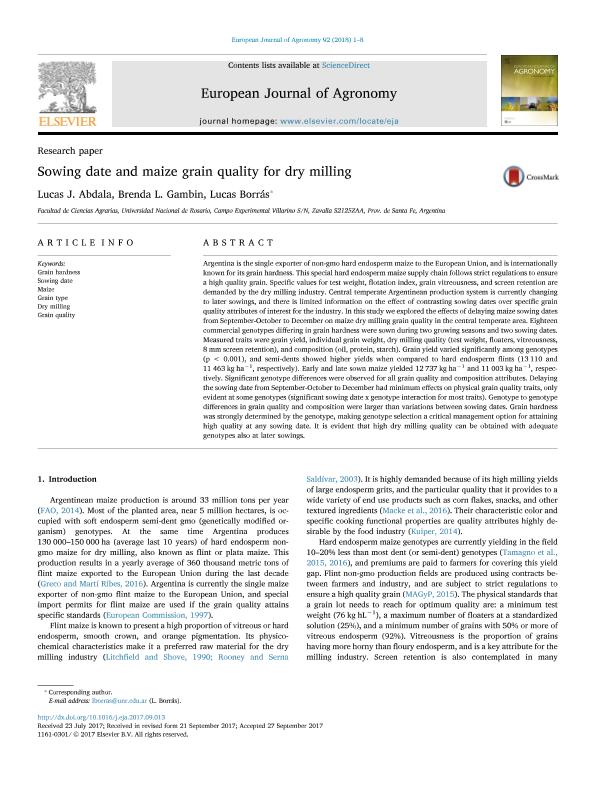Artículo
Sowing date and maize grain quality for dry milling
Fecha de publicación:
01/2018
Editorial:
Elsevier Science
Revista:
European Journal of Agronomy
ISSN:
1161-0301
Idioma:
Inglés
Tipo de recurso:
Artículo publicado
Clasificación temática:
Resumen
Argentina is the single exporter of non-gmo hard endosperm maize to the European Union, and is internationally known for its grain hardness. This special hard endosperm maize supply chain follows strict regulations to ensure a high quality grain. Specific values for test weight, flotation index, grain vitreousness, and screen retention are demanded by the dry milling industry. Central temperate Argentinean production system is currently changing to later sowings, and there is limited information on the effect of contrasting sowing dates over specific grain quality attributes of interest for the industry. In this study we explored the effects of delaying maize sowing dates from September-October to December on maize dry milling grain quality in the central temperate area. Eighteen commercial genotypes differing in grain hardness were sown during two growing seasons and two sowing dates. Measured traits were grain yield, individual grain weight, dry milling quality (test weight, floaters, vitreousness, 8 mm screen retention), and composition (oil, protein, starch). Grain yield varied significantly among genotypes (p < 0.001), and semi-dents showed higher yields when compared to hard endosperm flints (13 110 and 11 463 kg ha−1, respectively). Early and late sown maize yielded 12 737 kg ha−1 and 11 003 kg ha−1, respectively. Significant genotype differences were observed for all grain quality and composition attributes. Delaying the sowing date from September-October to December had minimum effects on physical grain quality traits, only evident at some genotypes (significant sowing date x genotype interaction for most traits). Genotype to genotype differences in grain quality and composition were larger than variations between sowing dates. Grain hardness was strongly determined by the genotype, making genotype selection a critical management option for attaining high quality at any sowing date. It is evident that high dry milling quality can be obtained with adequate genotypes also at later sowings.
Palabras clave:
DRY MILLING
,
GRAIN HARDNESS
,
GRAIN QUALITY
,
GRAIN TYPE
,
MAIZE
,
SOWING DATE
Archivos asociados
Licencia
Identificadores
Colecciones
Articulos(IICAR)
Articulos de INST. DE INVESTIGACIONES EN CIENCIAS AGRARIAS DE ROSARIO
Articulos de INST. DE INVESTIGACIONES EN CIENCIAS AGRARIAS DE ROSARIO
Citación
Abdala Alonso, Lucas Jorge; Gambin, Brenda Laura; Borras, Lucas; Sowing date and maize grain quality for dry milling; Elsevier Science; European Journal of Agronomy; 92; 1-2018; 1-8
Compartir
Altmétricas




